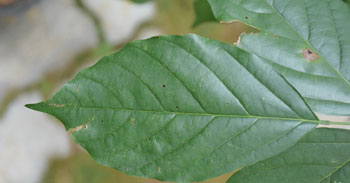KJC Medicinal Garden
honge mara
Pongamia pinnata
Order: Fabales
Family: Fabaceae
Genus: Pongamia
Species: pinnata
Common Names: Indian beech and Pongame oiltree
Native to South Asian region, (Eastern Himalaya, South India)
Other plants of the same genus with medicinal properties
-
M. speciosa (Traditional Medicine)
M. leucantha (Traditional Medicine)
M. pachycarpa (Chinese Medicine)
M. nitida (Chinese Herbal Medicine)
M. thonningii (Traditional Medicine)
M. laurentii (Traditional Medicine)
M. duchesnei (Traditional Medicine)
- Pongamia pinnata, is a legume tree. Root nodules promote Nitrogen Fixation.
- It grows about 15-25m in height.
- It has a straight or crooked trunk,50-80cm in diameter.
- Grey brown bark, smooth or vertically fissured.
- Branches are glabrous with pale stipulate scares.
Uses in Tradition systems of medicine
- Pongamai pinnata, it yields a black gum that has historically been used to treat wounds caused by poisonous fishes.
- Used in Ayurveda and Unani.
- Seeds contain oil (27-39%), Protein (17-37%), Starch (6-7%), Crude Fiber (5-7%), Moisture (15-20%) and Ash content (2-3%).
- Nearly half of the oil content of M. pinnata seeds is Oleic Acid.
- Oil has high content of tri-glycerides.
- Anti-Inflamatory.
- Anti-Plasmodial.
- Anti-Lipidperoxidative.
- Anti-Diarrhoeal.
- Anti-Ulcer.
- Anti-Hyperammonic.
- Anti-Oxidant.
- Anti-Bacterial.
Active Phytochemicals
1. Antioxidant and Anti-hyperammonemic Activity
It has been observed that effect of P. pinnata leaf extract on circulatory lipid peroxidation and antioxidant status was evaluated in ammonium chloride-induced hyperammonium rats. It enhanced lipid peroxidation in the circulation of ammonium chloride-treated rats was accompanied by a significant decrease in the levels of vitamin A, vitamin C, catalase. It showed that PPET modulates these changes by reversing the oxidant-antioxidant imbalance during ammonium chloride-induced hyperammonemia and this could be due to its anti-hyperammonemic effect by means of detoxifying excess ammonia, urea and creatinine and antioxidental Property.
2. Anti-diarrhoeal Activity
It has been evaluated that anti-microbial effect of crude decoction of dried leaves of P.pinnata and also evaluated its effect on production and action of enterotoxins (Cholera toxin, Escherichia coli labile toxin and E. coli stable toxin) and adherence of enteropathogenic E. coli and invasion of enteroinvasive E. coli and Shigella flexneri to epithelial cells. The decoction had no anti-bacterial, anti-giardial, and anti-rotaviral activities, but reduced production of cholera toxin and bacterial invasion epithelial cells.
3. Karangin
4. Glabrachalcone
5.Isopongachromene
References
1. “Plants profile for Millettia pinnata (Pongamia oiltree)”. Plants profile United States Department of Agriculture.
2. Ghufran A, Prem P, Maurya R. Furanoflavonoid glycosides from Pongamia pinnata fruits. Phytochemistry 2004; 65:921-4.
3. “Pongamia pinnata, Karum Tree, Poonga-Oil Tree, Indian Beech”. PFAF Plant Database. Retrieved 22 July 2021.

